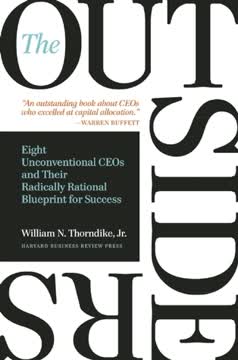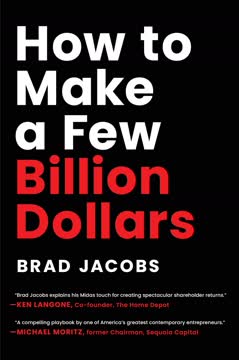نکات کلیدی
1. کارآفرینی از طریق خرید: مسیری منحصر به فرد برای مالکیت کسبوکار
شما میتوانید هماکنون یک کسبوکار کوچک موجود را خریداری کرده و به عنوان مدیرعامل آن را اداره کنید.
یک مسیر جدید کارآفرینی. کارآفرینی از طریق خرید، جایگزینی جذاب برای مسیرهای شغلی سنتی یا استارتاپهای پرخطر ارائه میدهد. این مسیر به حرفهایها اجازه میدهد تا مدیرعامل کسبوکارهای تثبیتشده شوند و از مهارتها و تجربیات مدیریتی خود بهرهبرداری کنند. این فرصت بسیار گسترده است و تنها در ایالات متحده حدود ۲۰۰,۰۰۰ کسبوکار مناسب وجود دارد.
مزایای مالی و سبک زندگی. خرید یک کسبوکار کوچک میتواند پاداشهای مالی قابل توجه و انعطافپذیری در سبک زندگی فراهم کند. مالکان اغلب معاملات را به گونهای ساختار میدهند که سهم اقتصادی معناداری را حفظ کنند و به طور بالقوه بازدهی قابل توجهی از سرمایهگذاری کسب کنند. علاوه بر این، اداره شرکت خودتان کنترل بیشتری بر تعادل کار و زندگی و توانایی اتخاذ تصمیمات تأثیرگذار ارائه میدهد.
مزایای کلیدی:
- نقش رهبری فوری
- پتانسیل بازدهی مالی بالا
- انعطافپذیری در تعادل کار و زندگی
- فرصت بهکارگیری مهارتهای مدیریت عمومی
2. شناسایی کسبوکار کوچک مناسب برای خرید: سودآوری پایدار کلید است
ویژگی اساسی کسبوکارهای سودآور پایدار، مشتریان تکراری است.
تمرکز بر ثبات. هدف ایدهآل برای خرید، کسبوکاری تثبیتشده با سابقهای از سودآوری مداوم و رشد آهسته و پایدار است. این کسبوکارهای "کسلکننده" اغلب بهترین فرصتها را برای موفقیت بلندمدت و کاهش ریسک فراهم میکنند.
ویژگیهای کسبوکارهای سودآور پایدار:
- مشتریان تکراری
- شهرت قوی
- رقابت محدود
- بخش ضروری اما نسبتاً کوچک از هزینههای مشتریان
- ادغام با عملیات مشتریان
از کسبوکارهای با رشد بالا، مبتنی بر فناوری یا دورهای اجتناب کنید، زیرا اغلب با افزایش ریسک و قیمتهای خرید بالاتر همراه هستند. در عوض، به دنبال شرکتهایی با جریان نقدی پایدار و مدل کسبوکار اثباتشدهای باشید که مهارتهای لازم برای مدیریت آن را دارید.
3. تأمین مالی خرید: تعادل بین بدهی، سهام و تأمین مالی فروشنده
خریداران معمولاً برای خرید یک شرکت کوچک حدود دو سوم قیمت خرید را قرض میگیرند.
ساختار تأمین مالی معمول:
- ۳۰-۵۰٪ بدهی ارشد (وامهای بانکی)
- ۲۰-۲۵٪ تأمین مالی فروشنده
- بخش باقیمانده از سرمایهگذاران سهام
استفاده از منابع متعدد. خریدهای موفق اغلب شامل ترکیبی از تأمین مالی بدهی و سهام است. وامهای ارشد از بانکها یا اداره کسبوکارهای کوچک (SBA) میتوانند بخش قابل توجهی از قیمت خرید را با شرایط مطلوب فراهم کنند. تأمین مالی فروشنده اعتماد فروشنده به کسبوکار را نشان میدهد و منافع آنها را پس از خرید با شما همسو میکند.
ملاحظات سهام. جمعآوری سهام از سرمایهگذاران برای تکمیل خرید ضروری است. سرمایهگذاران معمولاً انتظار بازدهی سالانه حدود ۲۵٪ برای ریسکهای مرتبط با سرمایهگذاریهای خصوصی در کسبوکارهای کوچک دارند. معامله خود را به گونهای ساختار دهید که بازدهی جذابی ارائه دهد در حالی که مالکیت کافی برای خودتان حفظ کنید.
4. یافتن خریدهای بالقوه: استفاده از کارگزاران و ارتباط مستقیم
یافتن از طریق کارگزاران موفقترین روش برای غلبه بر مشکلات ارائه شده توسط فروشندگان بیتعهد است.
مزایای کارگزار. همکاری با کارگزاران کسبوکار میتواند فرآیند خرید را ساده کند. کارگزاران اطلاعات سازمانیافتهای درباره شرکتهای فروشی ارائه میدهند، به مدیریت انتظارات فروشنده کمک میکنند و ارتباط بین خریداران و فروشندگان را تسهیل میکنند.
روش یافتن مستقیم. به طور متناوب، ارتباط مستقیم با صاحبان کسبوکار میتواند فرصتهای خارج از بازار را کشف کند و به معاملات بهتری منجر شود. این روش نیاز به تلاش بیشتری دارد اما میتواند چشماندازهای منحصر به فردی به همراه داشته باشد.
استراتژیهای یافتن:
- توسعه روابط با چندین کارگزار
- استفاده از پلتفرمهای آنلاین مانند Axial یا Dealnexus
- انجام ارتباط هدفمند با صاحبان کسبوکار در صنایع/مناطق مورد نظر
- استفاده از شبکههای شخصی و حرفهای
هر دو روش را متعادل کنید تا شانس خود را برای یافتن هدف خرید مناسب به حداکثر برسانید. آماده باشید تا صدها چشمانداز را بررسی کنید تا فرصت مناسبی را شناسایی کنید.
5. بررسی دقیق: تحقیق کامل برای اعتبارسنجی فرصت کسبوکار
بررسی دقیق فرآیندی تکراری است که شما آن را هدایت میکنید.
ارزیابی جامع. بررسی دقیق برای اعتبارسنجی درک شما از کسبوکار و کشف هرگونه مسائل بالقوه حیاتی است. این فرآیند شامل ارزیابیهای کیفی و کمی از عملیات، مالی و موقعیت بازار شرکت است.
مناطق کلیدی تمرکز:
- عملکرد مالی و شیوههای حسابداری
- روابط و رضایت مشتری
- انطباق قانونی و مقرراتی
- کارایی عملیاتی
- قابلیتهای تیم مدیریت
- روندهای صنعتی و چشمانداز رقابتی
از مشاوران حرفهای (حسابداران، وکلا) برای کمک به جنبههای تخصصی بررسی دقیق استفاده کنید، اما در فرآیند فعال بمانید. از یافتهها برای اصلاح پیشبینیهای مالی و استراتژی خرید خود استفاده کنید.
6. مذاکره در معامله: تدوین نامه نیت (LOI) برد-برد
LOI یک دست دادن است و به هر دو طرف اجازه میدهد با اطمینان معقول پیش بروند.
چارچوبی برای مذاکرات. نامه نیت (LOI) به عنوان نقشه راه برای خرید عمل میکند و شرایط کلیدی مانند قیمت خرید، ساختار تأمین مالی و تعهدات پس از خرید را مشخص میکند. در حالی که غیر الزامآور است، انتظارات را تعیین میکند و تعهد هر دو طرف را نشان میدهد.
اجزای کلیدی یک LOI:
- قیمت خرید و ساختار پرداخت
- جزئیات تأمین مالی (از جمله تأمین مالی فروشنده)
- دوره بررسی دقیق و انحصار
- برنامههای حفظ کارمندان کلیدی
- ترتیبات انتقال پس از بسته شدن
شرایطی را مذاکره کنید که از منافع شما محافظت کند در حالی که برای فروشنده منصفانه باقی بماند. آماده باشید تا بر اساس یافتههای بررسی دقیق تنظیم کنید، اما از بازگشایی مسائل حلشده مگر در موارد ضروری اجتناب کنید.
7. بستن خرید: پیمایش پیچیدگیهای قانونی و نهاییسازی توافقات
شما اکنون در سه جبهه جداگانه به سمت خرید خود حرکت میکنید: شما در حال تکمیل بررسی دقیق تأییدی خود هستید، با وامدهنده خود برای تکمیل بررسی دقیق آنها و مذاکره در مورد توافق وام کار میکنید و توافق سهامداران را با سرمایهگذاران سهام خود نهایی میکنید.
هماهنگی چندین جریان کاری. مراحل نهایی یک خرید شامل تلاشهای همزمان برای تکمیل بررسی دقیق، تأمین مالی و نهاییسازی توافقات قانونی است. این فرآیند نیاز به هماهنگی دقیق و توجه به جزئیات دارد.
ملاحظات کلیدی بستن:
- مذاکره در مورد توافق خرید
- مستندات تأمین مالی (وامهای بانکی، یادداشتهای فروشنده)
- توافقات سرمایهگذاری سهام
- توافقات استخدام و عدم رقابت
- تأییدیههای مقرراتی (در صورت لزوم)
با مشاور حقوقی خود به دقت کار کنید تا اطمینان حاصل کنید که تمام اسناد لازم به درستی تهیه و اجرا شدهاند. برای مسائل لحظه آخری آماده باشید و در یافتن راهحلها انعطافپذیر بمانید. به یاد داشته باشید که بستن پایان نیست، بلکه آغاز سفر شما به عنوان مالک کسبوکار است.
آخرین بهروزرسانی::
FAQ
What's "HBR Guide to Buying a Small Business" about?
- Overview: The book is a comprehensive guide on how to successfully purchase and manage a small business. It is part of the Harvard Business Review Guides series.
- Authors: Written by Richard S. Ruback and Royce Yudkoff, both professors at Harvard Business School, the book draws on their extensive experience in teaching and researching entrepreneurship through acquisition.
- Target Audience: It is aimed at managers considering a career change, newly minted MBAs, or anyone interested in becoming a business owner through acquisition.
- Content Structure: The book is divided into five parts, covering everything from preparing for a search to completing the acquisition and transitioning into ownership.
Why should I read "HBR Guide to Buying a Small Business"?
- Practical Guidance: The book offers step-by-step instructions on how to find, evaluate, and purchase a small business, making it a practical resource for aspiring entrepreneurs.
- Expert Insights: It provides insights from Harvard Business School courses, making complex concepts accessible to a broader audience.
- Financial Opportunities: The book highlights the financial benefits of buying a small business, such as potential high returns on investment.
- Risk Management: It offers strategies for mitigating risks associated with buying and running a small business.
What are the key takeaways of "HBR Guide to Buying a Small Business"?
- Entrepreneurship Through Acquisition: The book emphasizes buying an existing business as a viable path to entrepreneurship, offering both financial rewards and career flexibility.
- Enduring Profitability: Focus on acquiring businesses with recurring customers and stable cash flows to ensure long-term success.
- Due Diligence: Conduct thorough due diligence to confirm the business's financial health and the seller's commitment to sell.
- Financing Options: Explore various financing options, including bank loans, seller financing, and equity from investors.
What are the best quotes from "HBR Guide to Buying a Small Business" and what do they mean?
- "Think Big, Buy Small": This quote encapsulates the book's philosophy of achieving significant career and financial goals by acquiring a small, enduringly profitable business.
- "The Opportunity: Entrepreneurship Through Acquisition": This highlights the book's central theme that buying a business is a practical and rewarding path to entrepreneurship.
- "Managing the Risks of Ownership": This quote underscores the importance of understanding and mitigating the risks involved in owning a small business.
- "Reaping the Rewards: The Financial Opportunity": It emphasizes the potential financial benefits of buying a small business, such as high returns on investment.
How do I determine if entrepreneurship through acquisition is right for me according to the book?
- Self-Assessment: The book suggests evaluating your values, goals, and skills to determine if this path aligns with your personal and professional aspirations.
- Independence and Rewards: Consider if you value professional independence and direct rewards for your efforts, as these are key aspects of owning a business.
- Emotional Resilience: Assess your ability to handle the emotional ups and downs that come with entrepreneurship.
- Learning and Adaptability: Be prepared for continuous learning and adapting to new challenges in managing a business.
What is the acquisition process outlined in "HBR Guide to Buying a Small Business"?
- Four Phases: The process is divided into four phases: preparing for your search, finding the right business to buy, making an offer, and completing the acquisition.
- Preparation: This involves understanding the costs, raising funds, and identifying the characteristics you want in a business.
- Finding and Filtering: Source prospects through brokers or direct outreach and apply filters to identify viable acquisition targets.
- Due Diligence and Negotiation: Conduct thorough due diligence, negotiate terms, and finalize the purchase agreement.
How does the book suggest financing the acquisition of a small business?
- Debt and Equity: The book recommends using a combination of debt (bank loans, seller financing) and equity from investors to finance the purchase.
- Senior Loans: These are typically used to cover a significant portion of the purchase price and are secured against the business's assets.
- Seller Financing: This involves the seller providing a loan to the buyer, which is repaid over time, aligning the seller's interests with the business's success.
- Equity Investors: High-net-worth individuals can provide equity, expecting a return on investment, usually around 25% annually.
What are the characteristics of an enduringly profitable business according to the book?
- Recurring Customers: Businesses with a stable customer base that makes repeat purchases are considered enduringly profitable.
- Strong Reputation: A good reputation can keep customers loyal and deter competitors.
- Low Competition: Businesses with few competitors or high barriers to entry are more likely to maintain profitability.
- Stable Cash Flows: Consistent cash flows indicate financial health and reduce the risk of business failure.
How does "HBR Guide to Buying a Small Business" recommend conducting due diligence?
- Preliminary Due Diligence: Focus on understanding the business model, financials, and potential deal-breakers.
- Confirmatory Due Diligence: Validate initial findings with detailed financial analysis, legal checks, and customer and employee interviews.
- Professional Advisors: Engage accountants and lawyers to assist with financial and legal due diligence.
- Iterative Process: Continuously update your understanding of the business as new information becomes available.
What are the potential risks and rewards of owning a small business as outlined in the book?
- Risks: These include financial loss, management challenges, and market competition. The book emphasizes the importance of risk mitigation strategies.
- Rewards: Potential rewards include financial independence, high returns on investment, and personal fulfillment from running a successful business.
- Risk Management: The book advises buying businesses with stable cash flows and recurring customers to minimize risks.
- Long-Term Success: Focus on businesses with enduring profitability to ensure long-term success and financial stability.
How does the book suggest managing the transition after acquiring a business?
- Employee Communication: Clearly communicate your role and plans to employees to ensure a smooth transition.
- Cash Management: Implement a cash flow management system to avoid financial pitfalls.
- Customer Engagement: Meet with key customers to understand their needs and build relationships.
- Gradual Changes: Avoid making major changes immediately; take time to learn about the business before implementing new strategies.
What are the common mistakes to avoid when buying a small business according to the book?
- Overpaying: Avoid overpaying by conducting thorough due diligence and negotiating a fair price.
- Ignoring Red Flags: Pay attention to any red flags during due diligence, such as inconsistent financials or uncommitted sellers.
- Underestimating Costs: Be aware of all costs involved, including acquisition costs, working capital needs, and potential liabilities.
- Lack of Preparation: Ensure you are well-prepared for the acquisition process, from financing to transition management.
نقد و بررسی
کتاب راهنمای HBR برای خرید یک کسبوکار کوچک به خاطر مشاورههای عملی و دقیق خود در زمینهی خرید کسبوکارهای کوچک مورد تحسین قرار گرفته است. خوانندگان از رویکرد گام به گام این کتاب که همه چیز را از تأمین منابع تا بررسیهای دقیق پوشش میدهد، قدردانی میکنند. تمرکز کتاب بر روی کسبوکارهای "سودآور و پایدار" با مشتریان وفادار به عنوان بینش ارزشمند مورد تأکید قرار گرفته است. بسیاری از منتقدان این کتاب را منبعی ضروری برای خریداران نخستین بار میدانند که راهنماییهای واضح و مثالهای واقعی را ارائه میدهد. برخی اشاره میکنند که ممکن است در برخی زمینهها جزئیات بیشتری ارائه شود، اما بهطور کلی، این کتاب به عنوان یک منبع ضروری برای هر کسی که به خرید کسبوکار کوچک فکر میکند، شناخته میشود.
Similar Books














